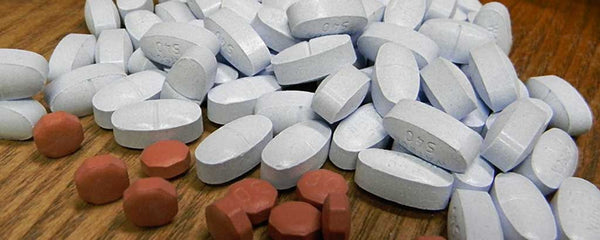Perhaps more troublesome, is when the arbitrators of pain—nerves themselves—malfunction.
« Login For Audio »
Pain Intense Enough For Opioids
All pain is sensory nerve pain. Nerve fibers run from our skin (integumentary system) and internal organs to key regions of our spine for the most rapid response in the event of injury. For further protection, our spine can even respond before our brain realizes the cause.
Sometimes endorphins and adrenalin temporarily kick in, allowing us to remove ourselves from harm’s way despite severe injury. This is followed by severe pain. A while after the physical threat is removed, the pain gradually subsides.
Then there’s chronic pain. This may occur as a result of trauma, shrapnel, or nerve damage. Unremovable fragments of sharp foreign matter can shift and cut internal muscles, organs, or skin. Like such wounds, damaged sensory nerves can constantly annoy us.
Getting to the Root of Pain
Nerves along the spinal column can become impinged. Commonly this is the result of a disc herniation but there are other factors. Perhaps more troublesome is when the arbitrators of pain—nerves themselves—malfunction. Neuropathic pain is defined as pain resulting from injury to the peripheral or central nervous system. It has been described as shooting or burning pain, tingling, and numbness. Neuropathic pain syndrome is experienced differently among patients.
Neuropathic Pain Syndrome Sources
- Trauma
- Ischemia
- Toxicity from alcohol, medications, or other substances
- Diabetes or renal failure
- Hereditary conditions
- Infections
- Immune-related conditions and chronic immune-related neuropathies
- Phantom limb pain
Clued by dermatome regions, neurologists employ various methods to track down specific neuropathic pain or neuropathy. After the nerves are damaged and neuropathy develops, abnormal signals from the peripheral nervous system and the central nervous system prevent the pain from easing. The aberration may be interrupted with nerve blocks, ablation or stimulation.
Invasive procedures are tempered with conservative treatment like ice packs, NSAIDs, physical therapy, and rest. During this quarantine period, errant nerve signals may continue to misfire. The ineffectiveness of conservative measures can lead, at least temporarily, to an immediate remedy.
Opioid to the Rescue
With the growing potential for abuse, doctors may reluctantly prescribe opiates. To curb addiction, they are provided in the lowest effective dose, usually mixed with an NSAID. Why are these effective? Opiates play mind games on nerve pain. The mind is flooded with natural chemicals signaling pleasure or euphoria—endorphins. Then the pain sensation is rewired or numbed. But there can be unpleasant side effects.
Opioid euphoria may cause patients to become glib, daring, and somewhat uninhibited. During this chattiness, secrets may be revealed, rash commitments made, or one can push themselves beyond physical limits. Remember, the source of pain is not eliminated while the sensation is obfuscated.

Opioids are technically categorized under the term narcotic. However, this medical use has diminished due to the negative association the term narcotic has with illegal drugs. Not all opioids (i.e. heroin) are available to be prescribed for pain treatment.
Relative Opioid Comparison
| Opioid | Strength | Dose |
|---|---|---|
| Ibuprofen (NSAID) | 1/222 | 2220 mg |
| Codeine | 1/10–3/20 | 67–100 mg |
| Hydrocodone | 80% | 10 mg |
| Morphine | 1 | 10 mg |
| Oxycodone | 1.5 | 6.67 mg |
| Morphine (IV/IM) | 3 | 3.33 mg |
| Methadone (acute) | 3–4 | 2.5–3.33 mg |
| Hydromorphone | 4 | 7.5 mg (oral), 1.5 mg (IV/IM) |
| Heroin (IV/IM) | 4–5 | 2–2.5 mg |
| Desomorphine | 8–10 | 1–1.25 mg |
| Enadoline | 25 | |
| Buprenorphine | 40 | 0.4 mg |
| Fentanyl | 50–100 | 0.1 mg |
| Sufentanil | 500–1000 | 0.01 mg |
| Etorphine | 1000–3000 | 3.3–10 µg |
| Lofentanil | 10,000–100,000+ |
People without chronic pain tend to eschew and critique the long-term use of practically any pain remedies. Acetaminophen, ibuprofen, cortisone, and opioids each have unpleasant side effects.
Unpleasant Hydrocodone Side Effects
Hydrocodone can be considered less intense in its cognitive euphoria than morphine or diacetylmorphine (heroin) due to the upper limit of how much can be converted into its active form through metabolism. It is still, however, capable of extreme intensity and overwhelming bliss at heavier dosages with a low tolerance.
The hydrocodone sensation itself can be described as a powerful and overwhelming feeling of emotional bliss, contentment, and happiness. It does not necessarily make pain pleasurable but it can make it tolerable during a distracting cognitive euphoria.
The pseudo relief can last a few hours as the body attempts to flush itself of the foreign chemical. During this time, side effects may include nausea, constipation, fatigue, headache, and other unpleasantness. Residual nerve numbing, sans euphoria, may linger the next day after succumbing to sleep. This vacation from pain is the reason many get caught up in a vicious cycle. The “vacations” get shorter, with a need for increasing doses. Stronger opioids can have more intense side effects.
“I would love to be off all of my medications and be living a pain-free life. I mean, that's obviously—that's the ultimate goal.” —Kate Leidy, fibromyalgia.
Symptoms of Opioid Overdose
Addiction is an insatiable, irreversible craving that can occur within a few days of regular opioid use. If any of the following symptoms of overdose occur while taking hydrocodone, get emergency help immediately:
- Blue lips and fingernails
- Blurred vision
- Change in consciousness
- Chest pain or discomfort
- Cold and clammy skin
- Confusion
- Constricted pupil (black part of the eye)
- Coughing that sometimes produces a pink frothy sputum
- Decreased awareness or responsiveness
- Dizziness, faintness, or lightheadedness when getting up suddenly from a lying or sitting position
- Increased sweating
- Irregular, fast or slow, or shallow breathing
- Lightheadedness, dizziness, or fainting
- Pale skin
- Sleepiness or unusual drowsiness
- Slow or irregular heartbeat
- Weak muscle tone
Premature death is more common among chronic pain patients. More than one in 10 Americans, or 25.3 million adults, suffer from pain every day, according to NIH data released in 2015. People who said they had “quite a bit” of pain were 38 percent likely to die during the study, while those who were in “extreme” pain regularly had an 88 percent increased risk.
Finding the Best Remedy
Even though pain is chronic—as in daily—months can elapse between doctor visits. It may take years for doctors to initiate invasive procedures. Healthcare professionals need to consider modeling protocols after opioid effectiveness while preventing opioid abuse.
The Centers for Disease Control & Prevention (CDC) released the first federal opioid prescription guidelines. “The goal is to help physicians rationally prescribe opioids,” pain management specialist Richard Rosenquist, MD at Cleveland Health Clinic. The CDC guidelines include suggestions such as:
- Look for non-opioid therapy options first.
- Talk to the patient about the risks and benefits of controlling pain with opioids.
- Start therapy with the lowest dose necessary, and increase the dose slowly—and only if needed.
- Limit opioid therapy for acute pain to less than three days. Prescribing opioids for more than seven days should typically be rare.
The government crackdown on opioids has made legal prescriptions harder for patients to receive. A large number of individuals with chronic pain and addiction are resorting to black-market drugs with lethal side effects.
Some anticonvulsant drugs also relieve the pain of neuropathies, possibly by stabilizing nerve cells. Neurontin—or its generic form, gabapentin—is sometimes used for opiate withdrawal. Gabapentin helps to relieve pain by slowing down the pain signals that travel through the nerves. As in the case of other pain relievers, a false sense of wellness can lead to musculoskeletal or organ damage if the underlying cause is neglected.
Dosage varies significantly among patients, affecting people in different ways. One of gabapentin’s benefits is its ability to mimic opiate effects in the body. But gabapentin has its side effects. Not the least of which is drowsiness. One in 500 patients may have suicidal thoughts. For many people, gabapentin is not as effective as opiates. To curb potential opioid addiction, doctors may prescribe and monitor NSAIDs separately or in combination with gabapentin.
Advil Versus Aleve Comparison
At 600 mg, Ibuprofen may cause drowsiness. That’s just three OTC 200 mg tablets. So you may choose between staying awake and relieving pain. Ibuprofen can cause ulcers and bleeding in the stomach and intestines at any time. A rare side effect is, coincidentally, backache. This medicine may increase the chance of a heart attack or stroke. The likelihood can increase with longer use of this medicine and in people who have heart disease.
Long-term use of any pain relieving drug has adverse consequences—especially in high doses. Longterm NSAID use can lead to ulcers and, depending on the medication taken, liver or kidney damage. Ibuprofen has “the broadest endocrine-disturbing properties identified so far in men.”
Take ibuprofen once every four to six hours, while 220mg naproxen is only repeated once every eight to 12 hours (though commonly prescribed in 500mg dosages). Naproxen sodium can cause drowsiness, dizziness, blurred vision, and ringing in the ears.
Taking two different NSAIDs together can increase the risk of side effects and serious adverse events. A 1984 study by The Manchester General Practitioner Group looked at 226 patients with osteoarthritis. Overall treatment preference significantly favored naproxen, concluded the researchers.
| Advil, Motrin | Aleve | |
|---|---|---|
| Dosage | 200–800 mg per dose | 220 mg (OTC dosage) |
| Forms | Advil available in tablets, chewable tablets, capsules, gelcaps, suspensions, and oral drops. | Aleve available in tablets, caplets, liquid gels, and gelcaps. |
| Active ingredient | Ibuprofen | Naproxen |
| Side effects | Nausea, dizziness, gastrointestinal bleeding | Higher incidence of photosensitivity and digestive tract problems. |
| Prolonged use | Hypertension; increased the risk of a heart attack or stroke | |
| Brand owner | Pfizer (formerly Wyeth) | Bayer |
| Action mechanism | Acts by inhibiting cyclooxygenases (COX-1 and COX-2) | |
| FDA approval | 1974 | 1991 (1994 OTC) |
| Benefits | Relief from body ache (including arthritis), fever reduction, anti clotting | |
| Over the counter | Yes | Yes |
Offering an inferior treatment might not be an unacceptable substitute for pain management. The body’s natural response to pain is to take immediate action to eliminate it. Pain psychologists counsel chronic suffers to view pain differently—to accept and cope with it. On the other hand, abrupt opioid withdrawal has adverse consequences.
Whichever pain reliever you take, try to get by with the lowest dose possible for the shortest amount of time. Prolonged use of opioids for lower back pain often means its cause is being ignored. Opioids quickly address both emotional and physical response to pain—temporarily. Whatever legal alternative treatment is offered, it should act similarly—for the longterm.
With proper oversight, long-acting and extended-release opioids can be controlled without unduly limiting their proper use. Insurance-covered physical therapy is elusive. Physicians need to promptly address underlying causes of chronic pain to effectively combat the opioid crisis if patients have any hope of feeling better.
To support the writing of useful articles about prescriptions, ClinicalPosters sells human anatomy charts, scientific posters, and other products online. You may sponsor specific articles, become a ClinicalNovellas Member, or remit a small donation.
ClinicalPosters sells human anatomy charts, scientific posters, and other products online to offset expense of the writing useful articles about prescriptions. Slide extra posters into DeuPair Frames without removing from the wall.
Show your support by donating, shopping for ClinicalPins, becoming a ClinicalNovellas Member, or leaving an encouraging comment to keep the research going.
To support the writing of useful articles about prescriptions, ClinicalPosters sells human anatomy charts, scientific posters, and other products online. You may sponsor specific articles or remit a small donation.
ClinicalPosters sells human anatomy charts, scientific posters, and other products online to offset expense of the writing useful articles about prescriptions. Slide extra posters into DeuPair Frames without removing from the wall.
ClinicalPosters sells human anatomy charts, scientific posters, and other products online. You may remit a small donation or become a ClinicalNovellas Member.
You can support the writing of useful articles about prescriptions by sponsoring specific articles, becoming a ClinicalNovellas Member, or remitting a small donation. Visible content is optimized for device size.







 Romance & Health Intertwine. Fall in love with a captivating romance miniseries that explores the essence of well-being. Become a ClinicalNovellas member for heartwarming tales.
Romance & Health Intertwine. Fall in love with a captivating romance miniseries that explores the essence of well-being. Become a ClinicalNovellas member for heartwarming tales.





